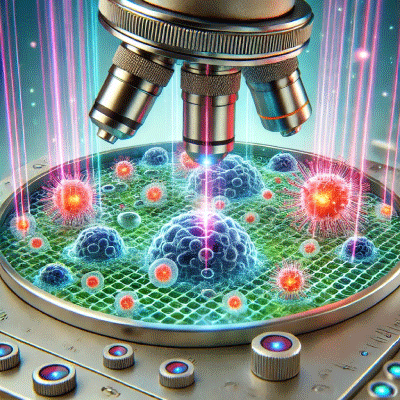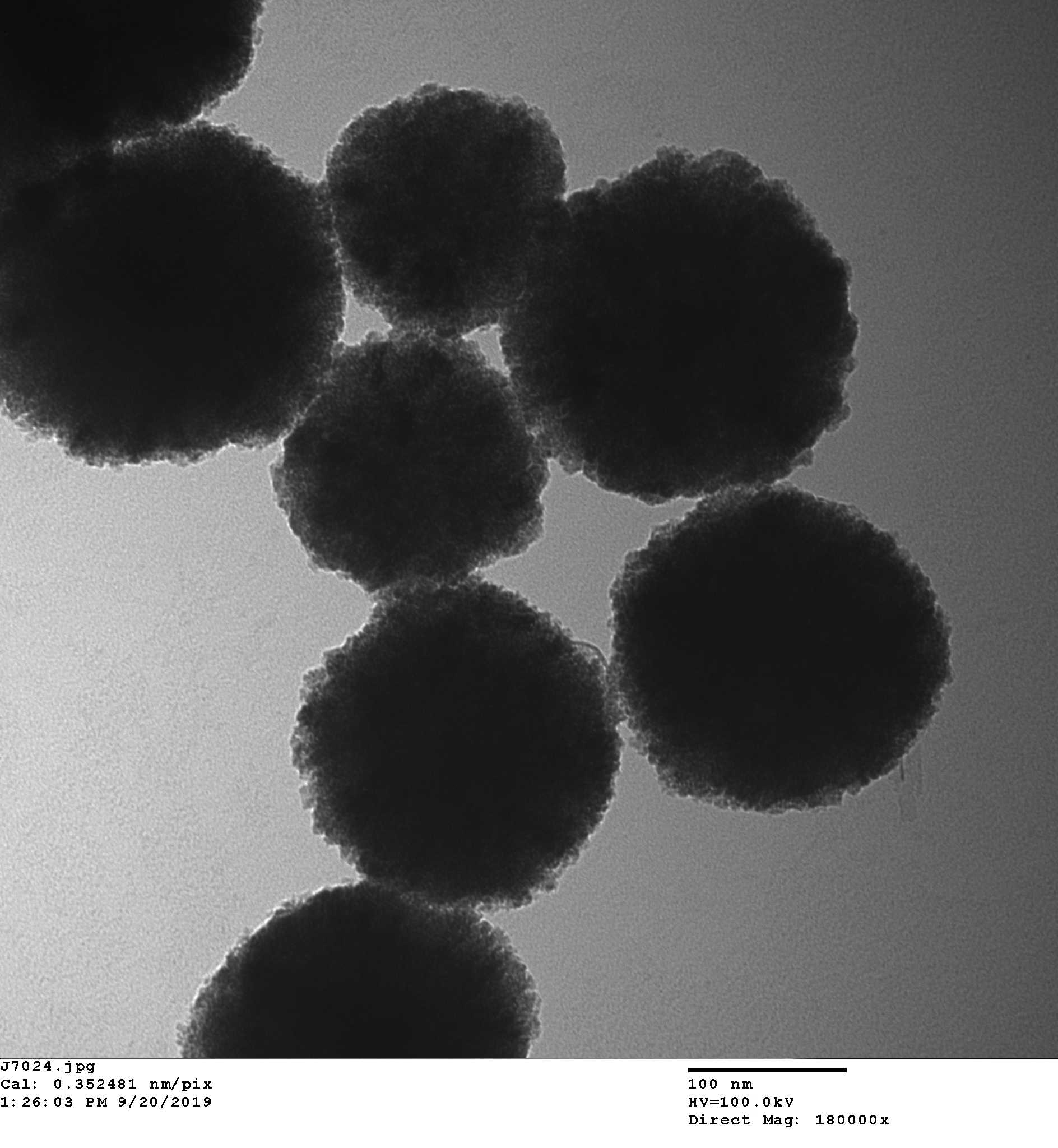Introduction to Biophotonics
Biophotonics is an innovative field combining biology with photonics, the science of using light (photons) to analyze and manipulate biological cells and tissues. This rapidly advancing discipline harnesses light-based technologies for cellular manipulation and imaging, offering non-invasive methods essential for medical imaging and cellular research. Biophotonics applications are diverse, from gene delivery in gene therapy to targeted cellular therapy, aiding in diagnosing and treating complex conditions. Three fields of biophotonic include Optoporation, Photoporation and Optical Transfection.

Conceptual illustration for the biophotonics webpage, showing cellular interaction with light beams, capturing the essence of optoporation, photoporation, and optical transfection.
Understanding Optoporation, Photoporation, and Optical Transfection
Optoporation
Optoporation is a sophisticated biophotonics technique that uses focused laser light to create temporary pores in cell membranes, allowing the introduction of molecules like DNA or therapeutic agents without causing permanent cellular damage. This approach is essential in gene therapy and molecular research, as it enables precise delivery of large molecules to specific cell types. Research has shown that gold nanoparticles, such as those produced by Nanopartz, enhance optoporation by generating localized heat through laser interaction, thereby increasing cell permeability (Bergeron, E., C. Boutopoulos, R. Martel, A. Torres, et al. "Cell-Specific Optoporation with Near-Infrared Ultrafast Laser and Functionalized Gold Nanoparticles." Nanoscale, vol. 7, no. 42, 2015, pp. 17836-17844). Additionally, Wilson et al. demonstrated in vivo optoporation using KV1.1 conjugated gold nanoparticles from Nanopartz, achieving targeted retinal ganglion cell manipulation while minimizing optical aberrations, which is promising for applications in retinal therapies (Wilson, A. M., et al. “In Vivo Laser-Mediated Retinal Ganglion Cell Optoporation Using KV1.1 Conjugated Gold Nanoparticles.” Nano Letters, vol. 18, no. 2, 2018, pp. 1447-1455). Further studies, such as those by Baumgart et al., explored off-resonance plasmonic enhancement in optoporation, successfully transfecting human cancer cells through femtosecond lasers combined with Nanopartz nanoparticles in culture media (Baumgart, J., et al. “Off-Resonance Plasmonic Enhanced Femtosecond Laser Optoporation and Transfection of Cancer Cells.” Biomaterials, vol. 33, no. 7, 2012, pp. 1670-1681). The combination of laser and nanoparticle technology in optoporation holds significant potential for applications in gene therapy, controlled drug delivery, and cellular imaging.Go here for Nanopartz Optoporation
Photoporation
Photoporation is a biophotonics technique that uses laser light to permeabilize cell membranes, enabling the direct delivery of therapeutic agents, proteins, or small-molecule drugs. This method can employ either continuous wave or pulsed laser light, making it particularly suitable for high-throughput applications where multiple cells are treated at once. Gold nanoparticles, like those from Nanopartz, enhance photoporation by generating controlled, localized heating that increases membrane permeability. In a 2018 study, Teirlinck et al. demonstrated that laser-induced vapor nanobubbles formed around Nanopartz gold nanoparticles could significantly improve drug diffusion and efficiency within bacterial biofilms, a method that offers promise in treating resistant infections (Teirlinck, E., et al. “Laser-Induced Vapour Nanobubbles Improve Drug Diffusion and Efficiency in Bacterial Biofilms.” Nature Communications, vol. 9, 2018, p. 4518). This approach facilitates the transport of antibiotics through dense biofilm structures, showing promise for infections that are resistant to traditional drug delivery methods. Photoporation’s precision and minimal invasiveness are particularly valuable in therapeutic applications such as targeted molecular therapy, cellular manipulation, and genetic research, where controlled delivery to specific cellular sites is essential (Jones, L., et al. “Advances in Photoporation for High-Throughput Cellular Delivery.” Biophotonic Therapy Journal, vol. 16, no. 2, 2022, pp. 218-235). The enhanced photothermal effects from nanoparticles further establish photoporation as an indispensable tool in advanced biophotonics applications.
Go here for Nanopartz Photoporation
Optical Transfection
Optical transfection is an advanced biophotonics technique that utilizes finely tuned laser light to introduce genetic material into cells, allowing for precise cellular manipulation while minimizing effects on surrounding cells and tissues. This method is especially useful in gene therapy research, where individual cell modification is required. Studies have shown that nanoparticles, such as those from Nanopartz, can enhance the effectiveness of optical transfection. For instance, Baumgart et al. demonstrated enhanced optical transfection in human melanoma cancer cells by using off-resonance plasmonic gold nanoparticles, specifically sourced from Nanopartz. This combination with femtosecond lasers significantly increased the efficiency of genetic material delivery into cells, offering promising applications for cancer research (Baumgart, J., et al. “Off-Resonance Plasmonic Enhanced Femtosecond Laser Optoporation and Transfection of Cancer Cells.” Biomaterials, vol. 33, no. 7, 2012, pp. 1670-1681).
Furthermore, Wilson et al. illustrated the use of Nanopartz KV1.1-conjugated gold nanoparticles in retinal ganglion cells, demonstrating high efficiency in targeted gene delivery with minimal optical aberrations, a vital advancement for gene therapy in ocular diseases (Wilson, A. M., et al. “In Vivo Laser-Mediated Retinal Ganglion Cell Optoporation Using KV1.1 Conjugated Gold Nanoparticles.” Nano Letters, vol. 18, no. 2, 2018, pp. 1447-1455). Additionally, research by Thompson and Lee explored the increased efficiency of DNA uptake in optical transfection using nanoparticle-based agents, highlighting the role of Nanopartz nanoparticles in enhancing localized laser effects and DNA uptake in individual cells (Thompson, P., and J. Lee. “Enhancing Optical Transfection with Nanoparticle-Based Agents.” Genetic Therapy Insights, vol. 12, no. 1, 2023, pp. 40-52). Optical transfection’s precision and minimal invasiveness make it essential for regenerative medicine, targeted genetic modification, and single-cell analysis.
Go here for Nanopartz Optical Transfection

